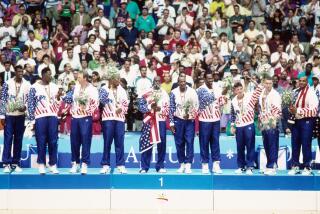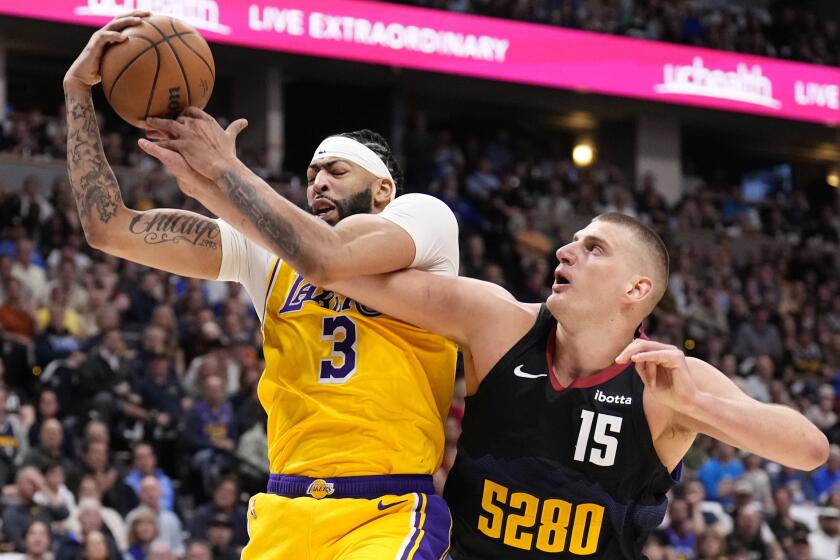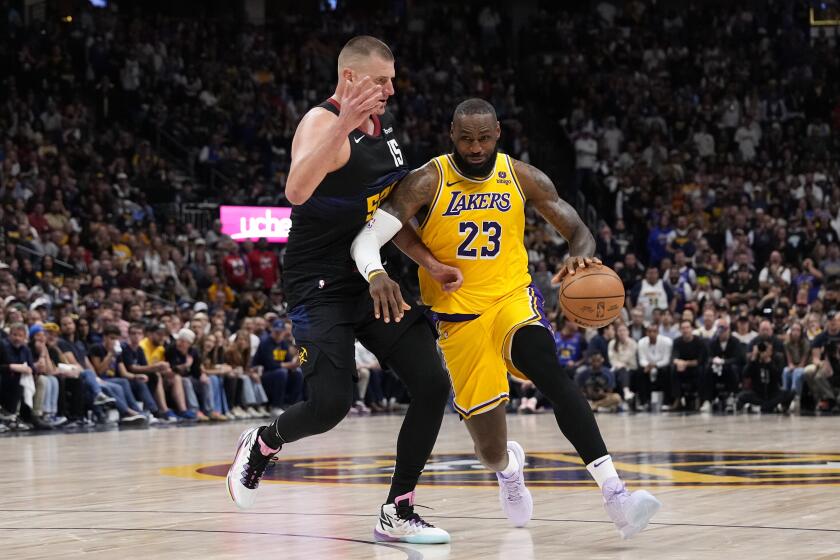London Olympics: 5 things to take from USA’s win over Lithuania
Below are five things to take away from Team USA’s 99-94 win Saturday over Lithuania in pool play.
1. LeBron James took over in the fourth quarter. The clock continued to tick down in a close game, and James looked more than eager just to facilitate. Yup, we all heard that one before, where James shrinks away from the pressure. But just as he showed in this year’s NBA Finals, James embraced it. After going scoreless for most of the fourth quarter, James staved off a possible Lithuania upset by scoring nine points in the final 3:58. His 20 points overall marked the same amount he had scored in the first three Olympic games combined.
It all started when James nailed a wide-open three at the top of the key, Chris Paul stole the ball on the next possession and James capped off the break with a dunk. Suddenly, the U.S. led 92-86 with 3:30 remaining. He didn’t stop there, though. James capped the effort by going isolation, resulting in an easy drive to the basket and a pull-up jumper that cemented Team USA’s lead at 99-90 with 1:12 remaining.
Team USA possessed other elements that contributed to the victory. Deron Williams made a key three-pointer to give the U.S. a 97-88 cushion at the 2:47 mark. Both Chris Paul and Kobe Bryant made two key offensive rebounds that set up two of James’ field goals. Team USA Coach Mike Krzyzewski continued playing small ball to ensure it could generate quick points. Both Bryant and Durant deferred to James on closing out the game.
But most of this reflects on James’ increased recognition on when to take over. His aggressiveness didn’t come as early as Team USA would’ve liked. But James recognized the moment his team most needed him. And he delivered.
2. Team USA played very disorganized for most of the game. Hardly any remnants of their 83-point blowout against Nigeria carried over against Lithuania. Not that anyone truly expected that. Lithuania, ranked No. 5 by FIBA, has won bronze medals in three of its six Olympic appearances (1992, 1996 and 2000). Toronto Raptors swing-man Linas Kleiza remains a scoring threat (posting 20 points on 10-of-20 shooting against the U.S.). But attribute plenty of this wire-to-wire game on Team USA playing sloppily. Their 10-of-33 mark from three-point range reflected the team rushing its shots. Attribute Team USA’s 19-of-31 mark from the free-throw line to a lack of focus. Blame Lithuania’s seven-of-16 mark from three-point range on Team USA’s slow reactions on rotations. Lithuania’s 23 points off turnovers also highlighted Team USA’s lack of defensive discipline.
How to go about solving these problems moving forward remains simple. Team USA has to take playing defense seriously or else a hot-shooting team could suddenly gain confidence. It also has to be more selective with its shots. The team’s identity still rests on outside shooting, and Team USA doesn’t exactly have the size to play a post-oriented game. But the difference between Saturday’s shooting performance and its 10-of-29 effort from three-point range against Nigeria had everything to do with what happened leading up to the shot. Against Lithuania, Team USA hoisted shots early in the shot clock without much ball movement. Against Nigeria, Team USA took open shots in rhythm and after moving the ball.
3. Carmelo Anthony maintained his sharp shooting. The lone exception proved to be Anthony. His 20 points on seven-of-13 shooting off the bench proved to be a nice followup to his 37 points against Nigeria. Anthony proved only so-so from three-point range (two-of-six). But most of his shots came in rhythm, including from catch-and-shoot jumpers and drives to the basket.
Even with how disorganized Team USA looked at times, it always knew how to set up Anthony well in the post, along the baseline and behind the perimeter. As for Anthony, he simply played the same way he has the entire Olympics. He penetrated off the ball, moved well into his shots and kept the same form that’s ensured so many good looks through four games.
4. Kobe Bryant struggled. More images of a changing of the guard took place late in the game where James completely took over the fourth quarter, while Bryant watched. This isn’t necessarily a knock against Bryant. To his credit, Bryant willingly deferred to James in making plays down the stretch even if it might have been tempting for him to force the issue. Bryant also grabbed a key offensive rebound that resulted in one of James’ field goals.
But even before that point, Bryant hardly offered much of any presence. His six points on one-of-seven shooting in 20 minutes reflected a few things. Bryant settled for quick three-pointers (zero of three from the field). Bryant went to the bench early around the eight-minute mark of the first quarter. Even with great footwork and rhythm, Bryant couldn’t find anything on fade-away and catch-and-shoot jumpers. Bryant was only effective at the free-throw line (four of five) after drawing a foul on a three-point shot and a drive to the basket.
Unlike the Lakers, Team USA can absorb a bad performance from Bryant. But it’s clear in these games that it will be hard for him to have much of an effect on the game unless he’s finding his shot early.
5. This should help in keeping Team USA grounded. Team USA should’ve never let it get to this point. But this game will prove to be better preparation for Argentina on Monday and the quarterfinals on Wednesday than any 83-point blowout. Such a scenario forced Team USA to dig deep and find its fourth-quarter identity. It also gives them plenty of things to work on, including outside shooting, free-throw shooting and defense, before the more difficult games begin starting with Argentina.
E-mail the Lakers blog at mgmedin@gmail.com. Follow the Lakers blog on Twitter.
More to Read
All things Lakers, all the time.
Get all the Lakers news you need in Dan Woike's weekly newsletter.
You may occasionally receive promotional content from the Los Angeles Times.






